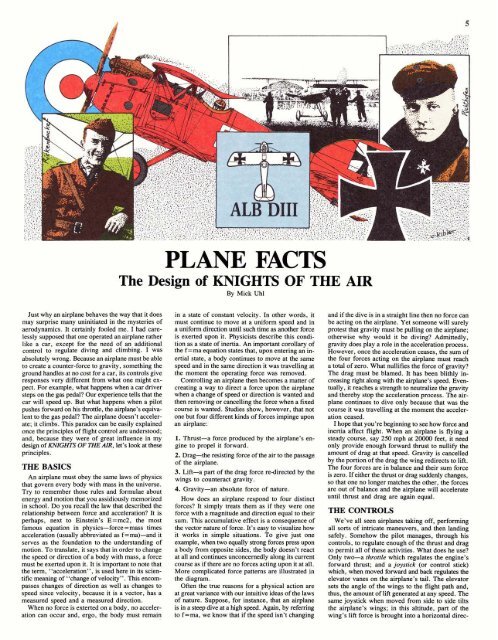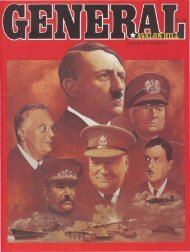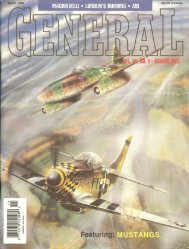18.64MB - View From The Trenches
18.64MB - View From The Trenches
18.64MB - View From The Trenches
- TAGS
- trenches
- www.vftt.co.uk
You also want an ePaper? Increase the reach of your titles
YUMPU automatically turns print PDFs into web optimized ePapers that Google loves.
Just why an airplane behaves the way that it does<br />
may surprise many uninitiated in the mysteries of<br />
aerodynamics. It certainly fooled me. I had care-<br />
lessly supposed that one operated an airplane rather<br />
like a car, except for the need of an additional<br />
control to regulate diving and climbing. I was<br />
absolutely wrong. Because an airplane must be able<br />
to create a counter-force to gravity, something the<br />
ground handles at no cost for a car, its controls give<br />
responses very different from what one might ex-<br />
pect. For example, what happens when a car driver<br />
steps on the gas pedal? Our experience tells that the<br />
car will speed up. But what happens when a pilot<br />
pushes forward on his throttle, the airplane's equiva-<br />
lent to the gas pedal? <strong>The</strong> airplane doesn't acceler-<br />
ate; it climbs. This paradox can be easily explained<br />
once the principles of flight control are understood;<br />
and, because they were of great influence in my<br />
design of XhlIGHTS OF THE AIR, let's look at these<br />
principles.<br />
THE BASICS<br />
An airplane must obey the same laws of physics<br />
that govern every body with mass in the universe.<br />
Try to remember those rules and formulae about<br />
energy and motion that you assidiously memorized<br />
in school. Do you recall the law that described the<br />
relationship between force and acceleration? It is<br />
perhaps, next to Einstein's E=mc2, the most<br />
famous equation in physics-force=mass times<br />
acceleration (usually abbreviated as f=ma)-and it<br />
serves as the foundation to the understanding of<br />
motion. To translate, it says that in order to change<br />
the speed or direction of a body with mass, a force<br />
must be exerted upon it. It is important to note that<br />
the term, "acceleration", is used here in its scien-<br />
tific meaning of "change of velocity". This encom-<br />
passes changes of direction as well as changes to<br />
speed since velocity, because it is a vector, has a<br />
measured speed and a measured direction.<br />
When no force is exterted on a body, no acceler-<br />
ation can occur and, ergo, the body must remain<br />
PLANE FACTS<br />
<strong>The</strong> Design of KNIGHTS OF THE AIR<br />
By Mick Uhl<br />
in a state of constant velocity. In other words, it<br />
must continue to move at a uniform speed and in<br />
a uniform direction until such time as another force<br />
is exerted upon it. Physicists describe this condi-<br />
tion as a state of inertia. An important corollary of<br />
the f =ma equation states that, upon entering an in-<br />
ertial state, a body continues to move at the same<br />
speed and in the same direction it was travelling at<br />
the moment the operating force was removed.<br />
Controlling an airplane then becomes a matter of<br />
creating a way to direct a force upon the airplane<br />
when a change of speed or direction is wanted and<br />
then removing or cancelling the force when a fixed<br />
course is wanted. Studies show, however, that not<br />
one but four different kinds of forces impinge upon<br />
an airplane:<br />
1. Thrust-a force produced by the airplane's en-<br />
gine to propel it forward.<br />
2. Drag-the resisting force of the air to the passage<br />
of the airplane.<br />
3. Lift-a part of the drag force redirected by the<br />
wings to counteract gravity.<br />
4. Gravity-an absolute force of nature.<br />
How does an airplane respond to four distinct<br />
forces? It simply treats them as if they were one<br />
force with a magnitude and direction equal to their<br />
sum. This accumulative effect is a consequence of<br />
the vector nature of force. It's easy to visualize how<br />
it works in simple situations. To give just one<br />
example, when two equally strong forces press upon<br />
a body from opposite sides, the body doesn't react<br />
at all and continues unconcernedly along its current<br />
course as if there are no forces acting upon it at all.<br />
More complicated force patterns are illustrated in<br />
the diagram.<br />
Often the true reasons for a physical action are<br />
at great variance with our intuitive ideas of the laws<br />
of nature. Suppose, for instance, that an airplane<br />
is in a steep dive at a high speed. Again, by referring<br />
to f=ma, we know that if the speed isn't changing<br />
and if the dive is in a straight line then no force can<br />
be acting on the airplane. Yet someone will surely<br />
protest that gravity must be pulling on the airplane;<br />
otherwise why would it be diving? Admittedly,<br />
gravity does play a role in the acceleration process.<br />
However, once the acceleration ceases, the sum of<br />
the four forces acting on the airplane must reach<br />
a total of zero. What nullifies the force of gravity?<br />
<strong>The</strong> drag must be blamed. It has been blithly in-<br />
creasing right along with the airplane's speed. Even-<br />
tually, it reaches a strength to neutralize the gravity<br />
and thereby stop the acceleration process. <strong>The</strong> air-<br />
plane continues to dive only because that was the<br />
course it was travelling at the moment the acceler-<br />
ation ceased.<br />
I hope that you're beginning to see how force and<br />
inertia affect flight. When an airplane is flying a<br />
steady course, say 250 mph at 20000 feet, it need<br />
only provide enough forward thrust to nullify the<br />
amount of drag at that speed. Gravity is cancelled<br />
by the portion of the drag the wing redirects to lift.<br />
<strong>The</strong> four forces are in balance qnd their sum force<br />
is zero. If either the thrust or drag suddenly changes,<br />
so that one no longer matches the other, the forces<br />
are out of balance and the airplane will accelerate<br />
until thrust and drag are again equal.<br />
THE CONTROLS<br />
We've all seen airplanes taking off, performing<br />
all sorts of intricate maneuvers, and then landing<br />
safely. Somehow the pilot manages, through his<br />
controls, to regulate enough of the thrust and drag<br />
to permit all of these activities. What does he use?<br />
Only two-a throttle which regulates the engine's<br />
forward thrust; and a joystick (or control stick)<br />
which, when moved forward and back regulates the<br />
elevator vanes on the airplane's tail. <strong>The</strong> elevator<br />
sets the angle of the wings to the flight path and,<br />
thus, the amount of lift generated at any speed. <strong>The</strong><br />
same joystick when moved from side to side tilts<br />
the airplane's wings; in this altitude, part of the<br />
wing's lift force is brought into a horizontal direc-
















